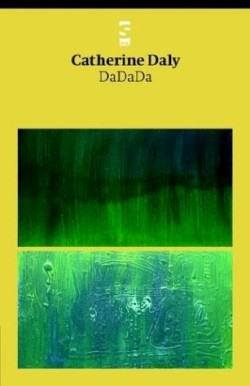DaDaDa
In Zurich in 1915 began the original Dada movement, a no-holds-barred assault on the conventional rationality, morality, and religion that had somehow plunged the world into war. Short-lived as it was, Dada’s edgy, sometimes playful iconoclasm played a major role in the avant-garde poetry and art of the last century. This book carries on the tradition, as the title suggests, although Gertrude Stein’s feminist language experiments are an even clearer antecedent. Not for readers yearning for conventional narratives or lyric poems, Daly’s work, like Stein’s, challenges and complicates our notions of what poems might be and do.
Each of the three sections of this generous volume might be a book in itself. The first, “Reading Fundamentals,” offers “readings” of various texts, including a series of poems called “Palm Anthology” related to the popular digital assistants. The typical mode is associative wordplay: “cavernous, rapacious vase, / carricle, / avaricious carapace, rapacious crevasse, / cat’s paw, blackwall, / capacious rapture on a plate.”
In part two, “Heresy,” Daly delves into historical characters, especially female saints and mystics. Again, her treatment of them is hardly conventional. The section opens with “Women’s Work,” which invokes “Beatri (((J. C) E), X) of Nazareth.” It opens with a bold section, unusually discursive for Daly: “Love is female, common / to lover and beloved, / shared, mediated, denominating, / seconded, second-hand …” However arguable these propositions, they lead into an extended exploration of both history and personal relations from a strongly, though obliquely, feminist perspective. “She dies alive, / dying feels hell’s fire, / life // insatiable, thirsty / can’t slake / can’t silence quiet quieted quietude.”
The poet, an Illinois Scholar at Trinity College and Merit Fellow at Columbia University, has worked as a technical architect, a Wall Street investment bank officer, an engineer, a software developer, and a teacher.
Her poems are most intriguing when they dance at the fringes of meaning and sense. Pieces like “(St.) Hildegarde von Bingen’s Visions” have beautiful moments: “Listen: little places of the ancient heart in the fountain. / See stone breathe.” In the lengthy series “In Medias Res,” the experiments at times slip over the border into less hospitable territory. “Dissolve” poems, in which lines are repeated without all but a few words or even letters, Ã la the famous fragments of Sappho, yield mostly tedious collocations: ’t at a e ’t ; / s s I e t at se ses d a ;…
“I can’t complete; completion is more like lying than speaking,” writes Daly. Some readers—even among those who enjoy her innovative gestures—may wish that she had made a few more concessions to convention. In another era of international violence, Daly might well have considered how much of the original Dada energy came from its fiercely antiwar stance. Unexpected pleasures await, however, those willing to explore this sometimes dazzling first collection.
Reviewed by
Jeff Gundy
Disclosure: This article is not an endorsement, but a review. The publisher of this book provided free copies of the book to have their book reviewed by a professional reviewer. No fee was paid by the publisher for this review. Foreword Reviews only recommends books that we love. Foreword Magazine, Inc. is disclosing this in accordance with the Federal Trade Commission’s 16 CFR, Part 255.

